47th AEROSPACE MECHANISMS SYMPOSIUM
May 15 – 17, 2024
Hosted by NASA Langley Research Center and Lockheed Martin Space.
Organized by the Mechanisms Education Association.
SYMPOSIUM OBJECTIVES
This symposium is concerned with the problems of design, fabrication, test, and operational use of aerospace mechanisms. Emphasis is on hardware developments. The symposium provides a social and technical forum for personnel active in the field of mechanisms technology, as well as providing a source of information for others interested in this field. The symposium rotates among eight NASA Centers and attracts papers and attendees from all over the world.
SYMPOSIUM LOCATION
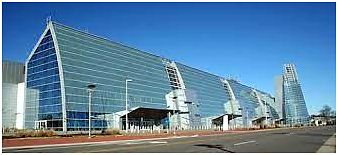
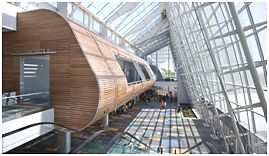 The Virginia Beach Convention Center is the site for all technical sessions. Check in and technical sessions will be on the second floor, and lunches and reception will be on the first (ground) floor.
The Virginia Beach Convention Center is the site for all technical sessions. Check in and technical sessions will be on the second floor, and lunches and reception will be on the first (ground) floor.
Virginia Beach Convention Center
1000 19th Street
Virginia Beach, Virginia 23451-5674 USA
SYMPOSIUM ACTIVITIES
The planned technical and social activities provide an opportunity for attendees to become professionally and personally acquainted. Dress attire is business casual unless otherwise noted.
MECHANISMS COURSES
On Monday and Tuesday, May 13 and May 14, three separate courses will be offered at the convention center. Registration for the Aerospace Mechanisms Symposium is not included in any class price.
Space Mechanisms Course (May 13-14)
Launchspace is providing a special edition of its Space Vehicle Mechanisms course. This course explores the technologies required for successful space mechanisms design and offers a detailed look at many of the key components common to most mechanisms. The materials necessary to achieve high performance are discussed. Examples of the many types of mechanisms are included for illustration. In addition, the mechanisms relationships and interfaces with other vehicle systems are explored. The course includes design and analysis examples to demonstrate principles involved in understanding how mechanisms should work and how design margins should be evaluated during the evolution of a program.
Register at: www.launchspace.com
The price for this course is $795.
Compliant Mechanisms Design (May 13-14)
Traditional rigid-body mechanisms consist of rigid links connected at movable joints. A compliant mechanism is a mechanism that gains at least some of its mobility from the deflection of flexible members rather than from movable joints only. This two-day course focuses on the basics of compliant mechanisms, modeling and simulation, materials selection, failure prevention and design.
Register at: www.launchspace.com
The price for this course is $795.
Rolling-Element Bearings: Fundamentals and Mechanics (May 13-14)
Examine fundamental geometry, kinematics, Hertzian contact mechanics, internal load distributions, preloading, stiffness and various nonlinear relationships of rolling-element bearings. Explore how system performance characteristics are affected by both internal bearing parameters and various bearing row configurations. Learn about boundary influences, such as fit-ups and relative thermal expansions, and gain knowledge related to the design, sizing, analysis and troubleshooting of rolling-element bearings. A minimum of 10 attendees is required to hold the course. Lunch and refreshments provided.
Register at: www.halpinengineeringllc.com
The price for this course is $1250.
Check-In
On Tuesday evening, May 14, from 6:00-8:00 PM, check in and registration will be in the Suite 1 Atrium, in the Virginia Beach Convention Center. Symposium materials will be available along with light refreshments.
Reception
On Wednesday evening, May 15, a reception will be held in Ballroom One in the Virginia Beach Convention Center. Supplier displays and poster papers will be exhibited during the evening along with demonstrations by a local school robotics team. A buffet dinner will be served. The reception is open for the enjoyment of all attendees and guests.
Symposium Banquet
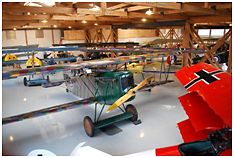
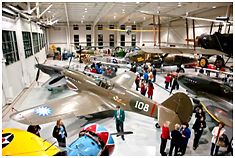 On Thursday evening, May 16, the symposium dinner open to all attendees and guests will be in the Military Aviation Museum. The museum is home to one of the world’s largest collections of flying vintage military aircraft. The facility includes over 50 aircraft from the World War I and World War II-era and a wide range of exhibits.
On Thursday evening, May 16, the symposium dinner open to all attendees and guests will be in the Military Aviation Museum. The museum is home to one of the world’s largest collections of flying vintage military aircraft. The facility includes over 50 aircraft from the World War I and World War II-era and a wide range of exhibits.
Facility Tours

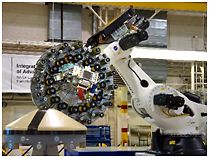 On Friday afternoon, May 17, there will be an opportunity to tour NASA Langley Research Center or the USS Wisconsin. Transportation is provided with symposium registration. The NASA Langley tour is a private tour open to only U.S. citizens and is limited to 50 persons; the USS Wisconsin is open to all attendees and guests.
On Friday afternoon, May 17, there will be an opportunity to tour NASA Langley Research Center or the USS Wisconsin. Transportation is provided with symposium registration. The NASA Langley tour is a private tour open to only U.S. citizens and is limited to 50 persons; the USS Wisconsin is open to all attendees and guests.
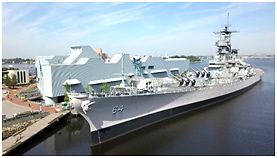
Guest Activities
Virginia Beach is a resort city with miles of beaches and hundreds of hotels, motels, and restaurants along its oceanfront. Nearby are historical places to visit such as Colonial Williamsburg and Jamestown. Virginia Beach is a 4-hour drive from Washington, D.C.
Presenters’ Meetings
Presenting authors are required to attend a complimentary breakfast on the day of their presentation. (Note – only the presenters, not all authors of the paper.) This gathering gives the session participants an opportunity to meet their Session Chair and each other, and to review the session arrangements. The Symposium AV help will be available to discuss presentation requirements.
SYMPOSIUM INFORMATION
Registration
Advance registration is requested to facilitate planning and commitments. Please register on www.aeromechanisms.com. The registration fee is $775 ($350 for full time educators, $300 for students, $250 for retirees). Registrants will obtain access to the proceedings as soon as they are available. NOTE: If the registration payment is received after 11:59pm EDT (GMT-4) April 15, 2024, the registration fee is $875. Also, any registrations started but unpaid before this deadline will also be revised to the late registration fee of $875. This fee covers all sessions, transportation as noted, reception and banquet and early access to the proceedings.
Refund Policy
If a registration is cancelled, the Mechanisms Education Association will refund all fees paid less $50, if cancelled by May 1, 2024. After May 1, no refunds are given. Alternatively, a registration may be transferred to another employee at the same company if the original registrant cannot attend if the request for the transfer is done prior to the symposium by contacting our registration point of contact (Ron Mancini, MEA Treasurer).
Hotels
There is no official symposium hotel; there are numerous hotel choices in Virginia Beach, particularly along the beach. Searching the region “Oceanfront” on this site will give you options (or use your favorite hotel search engine).
Dr. George Herzl Award
At each symposium, an award is given to the author(s) of the “Best Paper.” The award is based on paper content, presentation delivery, and visual aids. This award was established in honor of Dr. George Herzl of Lockheed Martin, a co-founder of the Aerospace Mechanisms Symposium.
Dr. Charles Coale Grant
Each year the Mechanisms Education Association sponsors high school and junior high school robotics teams in honor of Dr. Charles Coale of Lockheed Martin. Dr. Coale was the leader of the symposium for more than 20 years and had a special interest in helping children.
SYMPOSIUM PROGRAM AND TIMETABLE
| Time | Paper Title | Presenting Author / Co-Authors / Session Chair and Affliliations | File Download | ||
|---|---|---|---|---|---|
| Tuesday May 14, 2024 | |||||
| 18h00 - 20h00 | CHECK-IN – Meeting Room 2B, Suite 1 Atrium | ||||
| DAY-1: Wednesday May 15, 2024 | |||||
| 07h00 PDT | Presenters' Breakfast - Meeting Room 2A | ||||
| 08h00 | CHECK-IN - Meeting Room 2B | ||||
| 08h15 | INTRODUCTORY REMARKS | Ed Boesiger, General Chairman | Lockheed Martin Space, Sunnyvale, CA | ||
| Benjamin Nickless, Host Chairman | NASA Langley Research Center, Hampton, VA | ||||
| Clayton Turner, Center Director | NASA Langley Research Center, Hampton, VA | ||||
| Session I: RELEASE MECHANISMS | David Eddleman | NASA Marshall Space Flight Center, Huntsville, AL | Top Of Page | ||
| 08h30 | Caging and Release Mechanism Design for the Simplified Gravitational Reference Sensor | Joseph Footdale, Chad Sypolt, Joseph Mackin & Stephen Bennett, BAE Systems, Inc., Boulder, CO; John Conklin & Peter Wass, University of Florida, Gainesville, FL | footdale.pdf | ||
| 08h55 | Development Plan of the Upgraded Release Mechanism for the LISA Space Mission | Carlo Zanoni, National Institute for Nuclear Physics, Italy; Daniele Bortoluzzi, Davide Vignotto, Matteo Tomasi, Edoardo Dala Ricca, Abraham Ayele Gelan & Francesco Marzan, University of Trento, Trento, Italy; Paolo Radaelli, Riccardo Freddi & Alessandro Paolo Moroni, OHB Italia SpA, Italy | zanoni.pdf | ||
| 09h20 | FD04 Frangibolt Actuator Performance Test: Measuring Force and Stroke Margin | Ingie Baho & Kim Aaron, Jet Propulsion Laboratory, Pasadena, CA | baho.pdf | ||
| 09h45 | Development of an Ejectable Data Recorder (EDR) Ejection Mechanism for the Low-Earth Orbit Flight Test of an Inflatable Decelerator (LOFTID) | Brian Saulman & Robert Wagner, NASA Langley Research Center, Hampton, VA | saulman.pdf | ||
| 10h10 | 15 min Break | ||||
| 10h25 | LARES2 Mission: Retention and Separation Subsystem | Matteo Spinelli & Alessandro Bursi, OHB Italia, Milan, Italy; Simone Pirrotta & Roberto Bertacin, Italian Space Agency, Rome, Italy | spinelli.pdf | ||
| 10h50 | Design and Qualification of the Low-Earth Flight Test of an Inflatable Decelerator Payload Adapter Separation System (PASS) | Sean Hancock, Jacob Montgomery & Ben Nickless, NASA Langley Research Center, Hampton, VA; Matt Realsen, United Launch Alliance, Centennial, CO | hancock.pdf | ||
| 11h15 | Development and Testing of a Novel Solenoid Launch Lock for a Lunar Lander Thrust Vector Control Actuator | Joseph Plunkett, Honeybee Robotics, Longmont, CO | plunkett.pdf | ||
| 11h40 | Testing Frangibolts for Extended Space Mission Durations | Brian Gore, Ryan Hill & Timothy Woodard, The Aerospace Corporation, El Segundo, CA | gore.pdf | ||
| 12h20 | Lunch: Lunch for AMS Attendees in Ballroom One | ||||
| Session II: MATERIALS MEET MECHANISMS | Gilles Feusier | École Polytechnique Fédérale de Lausanne, Lausanne, Switzerland | Top Of Page | ||
| 13h20 | Development of a Bulk Metallic Glass Planetary Gearmotor for Unheated Actuation in Cryogenic Environments | Andrew Kennett & Robert Dillon, Jet Propulsion Laboratory, Pasadena, CA | kennett.pdf | ||
| 13h45 | Extreme Benefits of Visual Inspection under Magnification of Mechanical Components | Duval Johnson, Jet Propulsion Laboratory, Pasadena, CA | johnson.pdf | ||
| 14h10 | Motor Stator (Fluidize) Insulation Material Options and Testing Summary | Jonathan Wood & Emmett Donnelley-Power, Lockheed Martin Space, Sunnyvale, CA; Jessica Hamm, Sierra Space, Durham, NC; Recarda Schmitz, Windings, Inc., New Ulm, MN | wood.pdf | ||
| 14h35 | Ti Beta-C Spring Development Testing for Low Cycle, Cold Deep Space Applications | Pavlina Karafillis & Grady Lynch, Lockheed Martin Space, Denver, CO | karafillis.pdf | ||
| 15h00 | Break | ||||
| Session III: DRILLING MACHINES | Terry Nienaber | NASA Langley Research Center, Hampton, VA | Top Of Page | ||
| 15h30 | Lessons Learned in Building and Testing the Regolith and Ice Drill for Exploring New Terrain (TRIDENT) | Philip Chu, Samuel Goldman, Carter Fortuin, Vincent Vendiola, Helen Xu, Jaqueline Stamboltsian, Raymond Lin, Anchal Jain, Jack Wilson & Kris Zacny, Honeybee Robotics LLC, Altadena, CA | chu.pdf | ||
| 16h00 | Micro-Sampler: A Kilogram Class Drill for Planetary Sampling and Powder Collection | Nicklaus Traeden, Kathryn Bywaters, Damien Hackett, Gabriel Zwilinger, Christian Sipe, Peter Pulai & Kris Zacny, Honeybee Robotics LLC, Altadena, CA; Philippe Sarrazin & Maite Diez, SETI Institute, Mountain View, CA | traeden.pdf | ||
| 16h25 | Development of the DrACO Drill: A Rotary Percussive Drill for Cryogenic Operation | Grayson Adams, Matthew Dottinger & Patrick Corrigan, Honeybee Robotics LLC, Altadena, CA | adams.pdf | ||
| 16h45 | Break | ||||
| SESSION IV: POSTER SESSION PREVIEW | Mark Balzer | NASA Jet Propulsion Laboratory, Pasadena, CA | Top Of Page | ||
| A rapid fire session of poster papers. Each presenter will give their best 5-minute pitch and attendees can follow up at the reception or other time. | |||||
| 17h00 | Government Reference Design of the Vertical Solar Array Technology Demonstrator | Scott Belbin, NASA Langley Research Center, Hampton, VA | belbin.pdf | ||
| 17h05 | Bearings for Extreme Environments | Christoph Bayer & Thomas Kreis, GRW, Rimpar, Germany; David Nufer, GRW, Bloomfield, CT | bayer.pdf | ||
| 17h10 | Magnetic Fast Steering Mirrors for High Power Optical Communication | Etienne Betsch, Gérald Aigouy, Clément Cote, Augustin Bedek, Arnaud Barnique, Nicolas Bourgeot, Hugo Grardel, Pierre Personnat, Patrick Meneroud, Théo Simon, Marc Fournier, Sylvain Chardon, Frank Claeyssen & François Barillot, Cedrat Technologies, Meylan, France | betsch.pdf | ||
| 17h15 | Lessons Learned on Synchronization System Modelling for Solar Array Wing Deployment Predictions | Héloïse Boross & Philipp Schmidheiny, Beyond Gravity, Zurich, Switzerland | boross.pdf | ||
| 17h20 | Testbed for Lunar Extreme Environment Wear Tolerant Applications | Valerie Wiesner, Glen King, Keith Gordon & Christopher Wohl, NASA Langley Research Center, Hampton, VA; Christopher Domack & Brandon Widener, Analytical Mechanics Associates, Inc., Hampton, VA | wiesner.pdf | ||
| 17h25 | Development and Qualification of a New SADM for Small Satellites | Adrien Guignabert, Flavien Deschaux, Luc Herrero, Etienne Magnin-Robert, Comat Aerospace, Flourens, France; Jean-Bernard Mondier, CNES, Toulouse, France | guignabert.pdf | ||
| 17h30 | Development of a Shape Memory Alloy Thermostat | Alai Lopez, MIT Lincoln Laboratory, Lexington, MA; Kerri Cahoy, Massachusetts Institute of Technology, Cambridge, MA, USA | lopez.pdf | ||
| 17h35 | Programable Lead Screw Actuated Self-Leveling Platform | Iok Wong NASA Langley Research Center, Hampton, VA | wong.pdf | ||
| 17h40 | Aerocapture Technology Demonstration Risk Reduction Activity | Scott Belbin NASA Langley Research Center, Hampton, VA | belbin.pdf(2) | ||
| 18h00 - 22h00 | RECEPTION - Ballroom One | Component suppliers display current products and provide tutorials, Poster Papers are displayed, Robotics Team demonstrations, and a buffet meal. | |||
| DAY-2: Thursday May 16, 2024 | |||||
| 07h00 | Presenters' Breakfast - Meeting Room 2A | Top Of Page | |||
| Session V: DEPLOYMENT MECHANISMS | Matthew Zwack | NASA Marshall Space Flight Center, Huntsville, AL | |||
| 08h00 | Listening into the JUICE Deployments with the On-Board High Accuracy Accelerometer | Ronan Le Letty, Christian Erd & Alessandro Atzei, ESA/ESTeC, Noordwijk, The Netherlands; Massimiliano Pecora, THALES Alenia Space Italia, Gorgonzola, Italy; Luciano Iess, Sapienza University of Rome, Rome, Italy | leletty.pdf | ||
| 08h25 | Bricard Mechanism Based Engulfing Gripper for Space Debris Removal | Abhijith Prakash, Sankalp Vishnoi, Sandeep R & Biju Prasad B, Vikram Sarabhai Space Centre, Thiruvananthapuram, India | prakash.pdf | ||
| 08h50 | DIABLO – Deployable Interlocking Actuated Bands for Linear Operations; Design, Development, Testing, and Applications | Vishnu Sanigepalli, Robert Van Ness, Brian Vogel & Kris Zacny, Honeybee Robotics LLC, Longmont, CO | sanigepalli.pdf | ||
| 09h15 | A Modular Ready-to-Use Active Gravity Offloading System | Frederik Doll, Stefan Oechslein & Benjamin Krolitzki, CarboSpaceTech GmbH, Immenstaad am Bodensee, Germany | doll.pdf | ||
| 09h40 | 15 min Break | ||||
| 09h55 | Origami-Inspired, Re-Deployable, Compact Lunar Solar Array System | Alexander Gendell, Folditure, Hoboken, NJ | gendell.pdf | ||
| 10h20 | Design and Testing of a Deployment Mechanism for NASA’s 1653-m2 Solar Cruiser Sail | Zachary McConnel & Mark S. Lake, Redwire Space, Longmont, CO | mcconnel.pdf | ||
| 10h45 | Advanced Composite Solar Sail System (ACS3): Mechanisms and Lessons Learned from a CubeSat Solar Sail Deployer | Nigel Schneider, Analytical Services & Materials Inc., Hampton, VA; Gregory Dean, Olive Stohlman, Jerry Warren, Juan Fernandez, W. Keats Wilkie, Todd Denkins, NASA Langley Research Center, Hampton, VA | schneider.pdf | ||
| 11h10 | Design and Test of the Orion Crew Module Launch Abort System Hatch | Jeff Heyne, Aaron Larson, Ryan Dardar, Lance Lininger & Evan Siracki, Lockheed Martin Space, Houston, TX & Littleton, Co; Brian Emmett, NASA Langley Research Center, Hampton, VA | heyne.pdf | ||
| 11h50 | Lunch: Lunch for AMS Attendees in Ballroom One | Top Of Page | |||
| Session VI: INSTRUMENTS | Justin Scheidler | NASA Glenn Research Center, Cleveland, OH | |||
| 12h50 | Precision Actuation in the Flight Design of the Roman-CGI Focus Control Mechanism | Mineh Badalian, Johnathan W. Carson & Dalia Raafat, Jet Propulsion Laboratory, Pasadena, CA | badalian.pdf | ||
| 13h15 | A Dust-Resilient Thermal Shutter Mechanism for Lunar Radiators | Andrew Gibson, Olly Poyntz-Wright, Angus Bishop & Matthew Oldfield, ESR Technology Ltd. - European Space Tribology Laboratory, Warrington, UK; Angel Iglesias & Fabrice Rottmeier, Almatech, Lausanne, Switzerland; Martin Humphries, Spacemech Limited, Bristol, UK; Philipp B Hager, European Space Agency (ESA/ESTEC), Noordwijk, The Netherlands | gibson.pdf | ||
| 13h40 | An Introduction to Flexure Design | Johnathan Carson & Gary Y. Wang, Jet Propulsion Laboratory, Pasadena, CA | carson.pdf | ||
| 14h05 | Design and Test of Retention Mechanism to Apply Direction-Dependent Axial Force to Mars Returnable Sample Tube Assemblies | Jay Marion Jet Propulsion Laboratory, Pasadena, CA | marion.pdf | ||
| 14h30 | Tough Precision Piezoelectric Motors for Space Applications | Francois Barillot, Jocelyn Rebufa, Etienne Betsch, Jolan Gauthier, Alexandre Pagès & Nabil Bencheikh, Cedrat Technologies, Meylan, France | barillot.pdf | ||
| 14h55 | VenSpec-H Filter Wheel Mechanism Breadboard Development and Test | Gerhard S. Székely, Robert Eberli, Marco Grossmann & Samuel Tenisch, Lucern University of Applied Sciences & Arts, Horw, Switzerland; Hans-Peter Gröbelbauer, Florian Wirz & Pascal Seiler, University of Applied Sciences and Arts Northwestern Switzerland, Windisch, Switzerland; Paola Kögl & Stefan Kögl, KOEGL Space GmbH, Dielsdorf, Switzerland; Paul Tackley & Taras Gerya, Zürich, Switzerland; Ann-Carine Vandaele & Eddy Neefs, Royal Belgian Institute for Space Aeronomy, Brussels, Belgium | szekely.pdf | ||
| 15h20 | Break | Top Of Page | |||
| Session VII: GIMBALS | Jason Schuler | NASA Kennedy Space Center, Kennedy Space Center, FL | |||
| 15h50 | Development of an Advanced 2-Axis Electrical Propulsion Pointing Mechanism | Paul Janu, Daniel Ruckser, Jarmila Suhajdova & Zoran Ignjatov, Beyond Gravity, Wien, Austria; Mario Toso, ESA/ESTeC, Noordwijk, The Netherlands | janu.pdf | ||
| 16h15 | MPCV SADA for Artemis Program: A Story of Increasing Demands and Continuous Improvement | Josef Viktor Zemann, Paul Joachim Schüngel & Matthias Schmalbach, Beyond Gravity, Zurich, Switzerland | zemann.pdf | ||
| 16h40 | Development and Qualification of an Electrical Thruster Two Axis Pointing Mechanism | Richard Horth MDA, Quebec, Canada | horth.pdf | ||
| 17h05 | SPECIAL PRESENTATION – Astronaut and F-22 Pilot, Major Nicole Ayers | 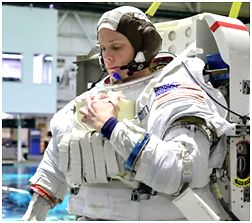 | Astronaut and F-22 Pilot, Major Nicole Ayers Nichole Ayers was selected by NASA to join the 2021 Astronaut Candidate Class. She graduated from the U.S. Air Force Academy with a bachelor’s degree in mathematics and later earned a master’s degree in computational and applied mathematics from Rice University. She became an instructor pilot in the T-38, leading adversary missions that provided combat training for the F-22 Raptors at Langley AFB. As one of the few women to have flown the F-22 Raptor, Ayers led the first-ever all-woman F-22 formation in combat in 2019 with more than 200 combat hours in Operation Inherent Resolve over Iraq and Syria. | ||
| 19h00 - 23h00 | BANQUET - Military Aviation Museum | Dinner and entertainment amongst World War II vintage airplanes. | |||
| DAY-3: Friday May 17, 2024 | |||||
| 07h00 | Presenters' Breakfast - Meeting Room 2A | ||||
| Session VIII: THE STU LOEWENTHAL TRIBOLOGY SESSION | Stu Loewenthal | Lockheed Martin Space (Retired), Sunnyvale, CA | Top Of Page | ||
| 08h00 | Dry-Film Lubricated Ball Bearing Tests for High-Speed, Moderate-to-Long Life, Cryogenic Operation | Robert Wei, Gale Paulsen, Andrew Bocklund, Nate Jensen, Zach Begland & Tim Newbold, Honeybee Robotics LLC, Altadena, CA | wei.pdf | ||
| 08h25 | Cold Welding under Space and Launch Conditions | Roland Holzbauer & Andreas Merstallinger, Aerospace & Advanced Composites GmbH, Wiener Neustadt, Austria; Lionel Gaillard & Nathan Bamsey, European Space Agency, Noordwijk, The Netherlands | holzbauer.pdf | ||
| 08h50 | Qualification of Rheolube 3000-3Pb for the BABAR-ERI Chopper Mechanism | Darren Erickson, Laboratory for Atmospheric and Space Physics, University of Colorado, Boulder, CO; Bob Hoffman, NYE Lubricants (Member of the FUCHS Group) Inc., Fairhaven, MA | erickson.pdf | ||
| 09h15 | 15 min Break | ||||
| 09h30 | Development of Strain Wave Gearing Lubrication for the Steering Unit for The Manned Pressurized Rover | Jun'ichi Kurogi, Yoshihide Kiyosawa, Masaru Kobayashi & Takuya Akasaka, Harmonic Drive Systems Inc, Nagano-ken, Japan; Hiroyuki Toyoda & Shoichi Shono, Toyota Motor Corporation, Japan; Shingo Obara, Koji Matsumoto & Nobuo Kenmochi, Japan Exploration Agency, Japan | kurogi.pdf | ||
| 09h55 | On the Potential of Orthoborate Ionic Liquids to Meet Lubrication Challenges in Space Mechanisms | Roman de la Presilla, KTH Royal Institute of Technology, Stockholm, Sweden; Oleg Antzutkin, Luleå University of Technology, Luleå, Sweden; Sergei Glavatskih, University of New South Wales, Sydney, Australia and Ghent University, Ghent, Belgium | delapresilla.pdf | ||
| 10h20 | Design and Test of Bearings Used in Electromechanical Systems under High Vibration Environments | Kyle Gotthelf, Javier Becerra & Andrew Maurer, Honeybee Robotics LLC, Longmont, CO | gotthelf.pdf | ||
| 10h45 | Development and Qualification of an Extreme Mechanical Live Antenna Pointing Mechanism, part of the Inter Satellite Link of an ESA Mission Spacecraft | Richard Horth MDA, Quebec, Canada | horth.pdf(2) | ||
| 11h10 | SPECIAL PRESENTATION – SHOCK QUALIFICATION OF AIRCRAFT CARRIERS | Michael Reilley and Michael Talley | Huntington Ingalls Industries, Newport News Shipbuilding This area of Virginia is a key shipbuilding area for the United States. Satellites have to design for shock from release devices all the time and this presentation will give you another perspective! | ||
| 11h40 | TECHNICAL SESSIONS CONCLUSION | Jonathan Wood | Lockheed Martin Space, Sunnyvale, CA | ||
| Herzl Award Presentation | |||||
| 12h00 | Lunch: Lunch for AMS Attendees in Ballroom One | ||||
| 13h00 - 17h00 | TOURS | ||||
| 13h00 | Busses depart Convention Center for NASA Langley or USS Wisconsin | ||||
| 17h00 | Approximate time busses return to Convention Center | ||||
SYMPOSIUM ORGANIZING COMMITTEE
Host Chairs:
- James Wells, NASA LaRC
- Benjamin J. Nickless, NASA LaRC
General Chairman: Edward A. Boesiger, Lockheed Martin Space
Deputy Chairman: Jonathan P. Wood, Lockheed Martin Space
Mark A. Balzer, JPL
Torin L. Bowman, NASA ARC
Earl Daley, NASA ARC
Michael J. Dube, NASA NESC
David E. Eddleman, NASA MSFC
Carlton L. Foster, NASA MSFC (retired)
Lionel Gaillard, ESA/ESTeC
Nicolas E. Haddad, JPL
Claef F. Hakun, NASA GSFC
Louise Jandura, JPL
Timothy L. Krantz, NASA GRC
Lance R. Lininger, Lockheed Martin Space
Alan C. Littlefield, NASA KSC (retired)
Stuart H. Loewenthal, Lockheed Martin Space (retired)
Ronald E. Mancini, NASA ARC (retired)
Fred G. Martwick, NASA ARC
Donald H. McQueen, Jr., NASA MSFC (retired)
Landon Moore, NASA JSC
Brandan Robertson, NASA JSC
Justin J. Scheidler, NASA GRC
Joseph P. Schepis, NASA GSFC
Jason M. Schuler, NASA KSC
Donald R. Sevilla, JPL (retired)
Mathew R. Zwack, NASA MSFC
